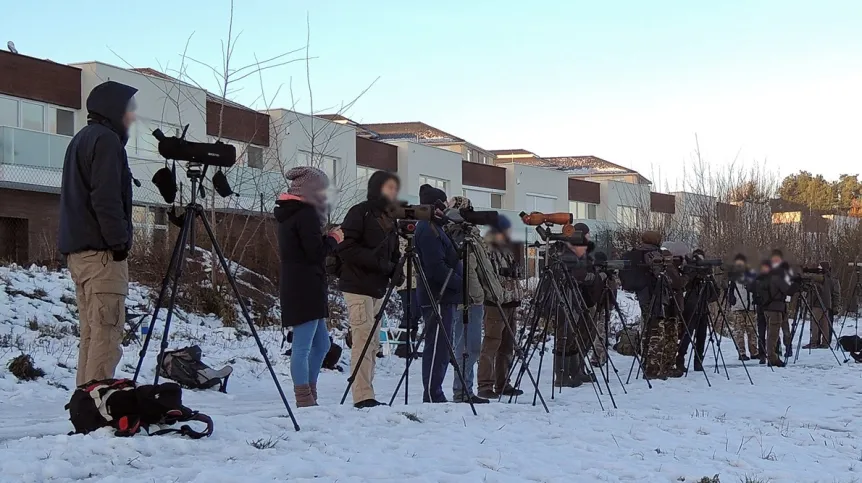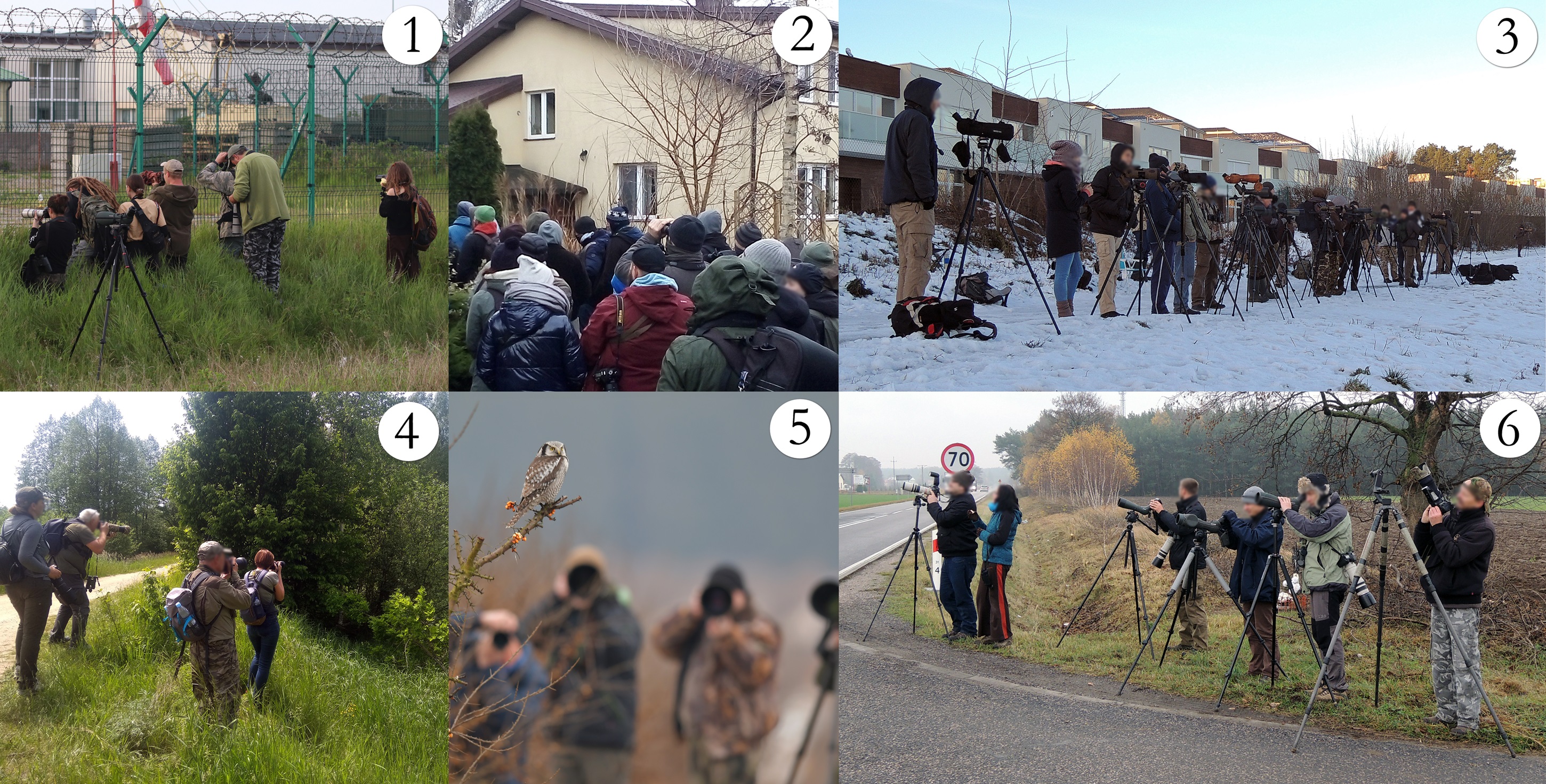
In recent years, birdwatchers have shown an increase in interest in rare birds. This may be related to the growing popularity of the hobby and the rapid spread of information about rare sightings via social media, say researchers.
Birdwatching is a global passion that attracts people from all walks of life who want to see and document wild birds in their natural habitat. Some birdwatchers appreciate the peace and quiet of everyday observations. Others are fuelled by the adrenaline of spotting a rare species - a phenomenon known as 'twitching'. In a new study, an international team led by scientists from the Poznań University of Life Sciences and the Institute for Advanced Study at the Technical University of Munich delved into what really drives birders to gather for rare sightings. The study sheds light on the culture of birdwatchers and shows how social factors influence their behaviour. The results were published in People and Nature.
A thorough study of birdwatchers' behaviour in Poland has revealed key factors that influence the sizes of groups that gather for rare sightings.
While analysing more than 103 such events - from 1996 to 2022 - the researchers interviewed birdwatchers and collected photographic evidence. They found that several factors influenced group size, including species rarity, the year of the sighting, proximity to cities, and the increasing participation of women in the activity.
'Understanding what motivates birdwatchers to gather for rare observations is important not only for the community itself, but also for nature conservation and ecotourism', says Professor Piotr Tryjanowski from Poznań University of Life Sciences, the first author of the study.
The study confirmed common sense intuition: the rarer the bird, the larger the crowd. In recent years, there has been a visible trend of a growing number of participants in such gatherings, the scientists say. The increased interest may be related to the growing popularity of this hobby and the rapid spread of information about rare observations thanks to social media.

Proximity to cities was also important - the more distant the location, the less interest.
The researchers have also found that women are increasingly attending such gatherings, and are more likely to attend moderately rare sightings (while men 'scurry for extremely rare species'). This shift reflects a broader cultural shift in the birdwatching community. 'Birdwatching has long been seen as a male activity, but in the last decade we have seen more and more women engaging in the activity', says Dr. Peter Mikula. 'This shift is similar to trends in other countries and may indicate a cultural transformation of the hobby'.
The findings have implications for the birdwatching, ecotourism and conservation communities, because birdwatchers can be instrumental in documenting rare species. Understanding what drives their behaviour allows scientists and conservationists to better promote birdwatching tourism and citizen science initiatives.
'We have taken up the subject of birdwatchers grouping together around rare species because this issue is poorly understood and described in the literature, and even less known to a wider audience, not related to ornithology', says Dr. Michał Polakowski from the Institute of Biology at the University of Szczecin. 'Interest in bird watching and photographing is growing in Poland. This fascinating activity is certainly promoted by the rapid flow of information about observations, which today takes place not only via landline telephone (as it was 30 years ago), but also via mobile phones, the Internet, social media and various messengers'.
Dr. Polakowski adds that more and more people are also involved in the so-called 'twitching' of rare birds for their individual species lists. 'The record holder in Poland has seen 399 of all 477 species recorded in the country - and there are certainly over 100 people who have observed at least 300 species. In the last century, much fewer people engaged in such observations - mainly men, and in the number of a few, sometimes a dozen or so. Currently, this group has significantly increased, and there are more among the watchers. For example, in October 2024, over 100 people came to Jastarnia in Hel to admire the extremely rare Radde's warbler, which appeared in Poland for only the tenth time.
'In time, we can expect similar phenomena in Poland to those in countries where birdwatching is much more popular, e.g. in England or Finland’.
In those countries, hundreds of people often immediately go to places where an exceptionally rare species of bird has appeared.
Scientists have long been warning against satisfying the need for observation at the expense of the environment, birds and their habitats. Professor Tryjanowski presented examples of unethical behaviour of some watchers in the book Rozum z ptakami odlatuje (2018), describing cases of people whose fascination with birds borders on obsession, and whose desire for competition is sometimes stronger than curiosity.
Victims of thoughtlessness associated with photography included the Eurasian stone-curlew, pestered by 'bird lovers' right next to its nest, the last one in Poland. In turn, in March 2023, scientists from the Mammal Research Institute of the Polish Academy of Sciences in Białowieża appealed for common sense to 'lovers' of the pygmy owl, which appeared near the institute's building. 'We could watch it from the Institute's window without scaring it away or disturbing its rest. Unfortunately, information about the pygmy owl's presence spread through several Facebook groups and for two days we watched a photographer who stood for hours with a loudspeaker and, by playing the male pygmy owl's voice, tried to force the owl to fly lower so that he could take a perfect photo', the Institute reported. Scientists warned that as a result of this behaviour, the bird could starve (because instead of hunting, it would listen to its rival's voice); it could become careless and be attacked by a predator, e.g. a sparrowhawk; during the breeding season, it could stop feeding its young; the played voice exposed the pygmy owl to high stress caused by imitating a loud rival; the voice of the pygmy owl attracted the attention of passerine birds, which could start to harass it.
The spirit of ethical conduct in contact with nature is reflected in the code of ethics of the Association of Polish Nature Photographers. The main message of the code is that the well-being of the photographed object and its environment is 'significantly more important' than taking the photo. When taking photos in the field, the photographer should put the safety of animals first and avoid disrupting their lives, 'especially during the breeding season'. According to the recommendations, photographers should not leave clear traces of their presence. They should not deliberately visit the sites of species susceptible to scaring. Animals should not be disturbed in their sleeping places. The code draws attention to the fact that taking photos in the protection zones of the sites of endangered species of plants, fungi or animals may only take place after obtaining permits.
PAP - Science in Poland
zan/ kap/
tr. RL













